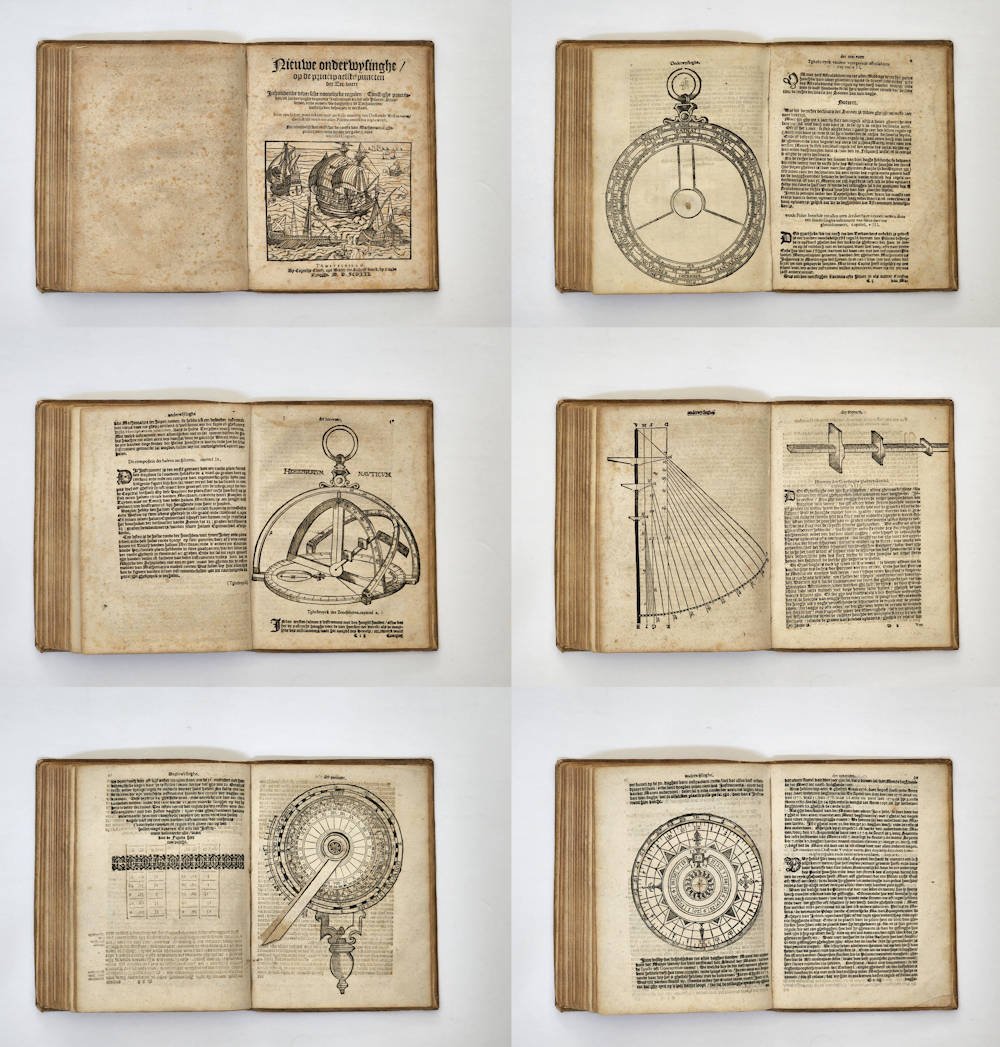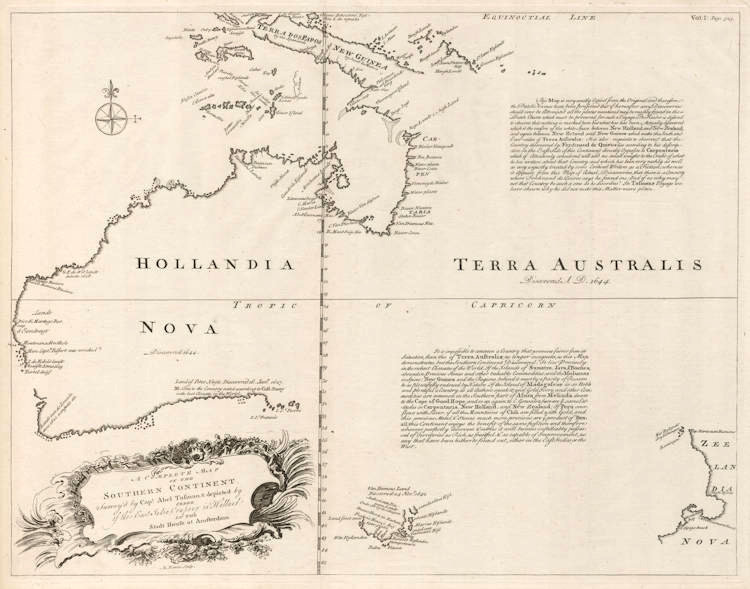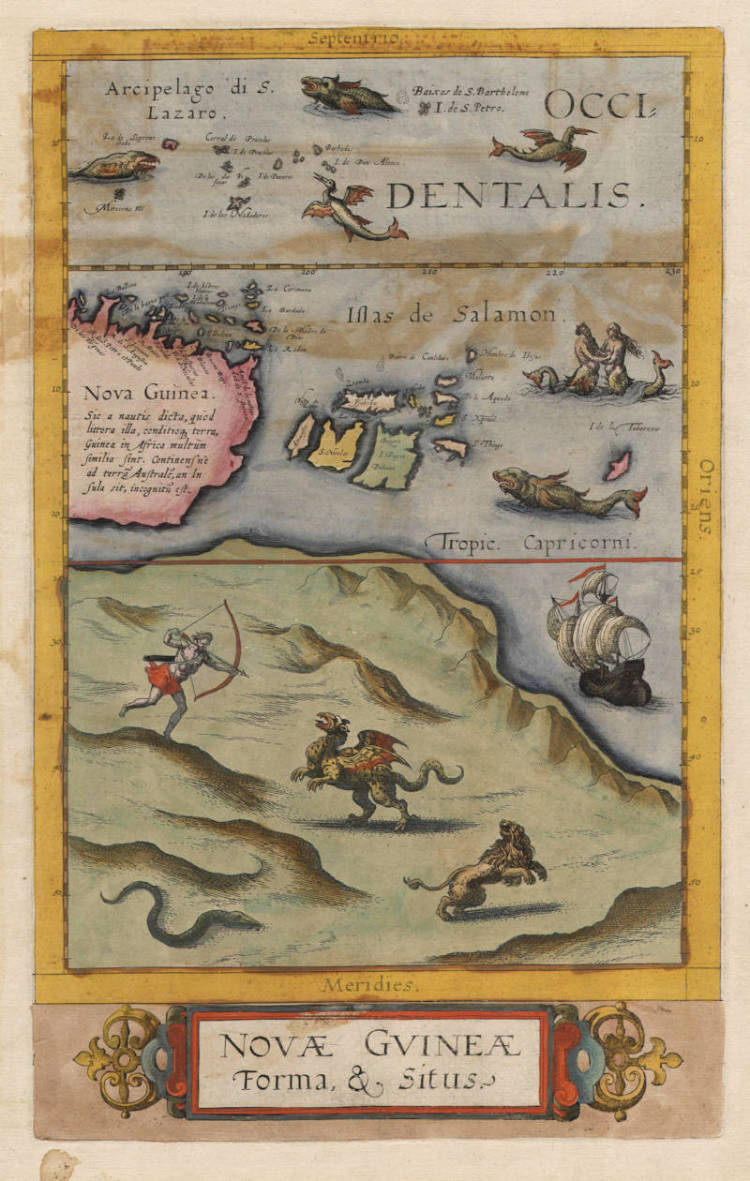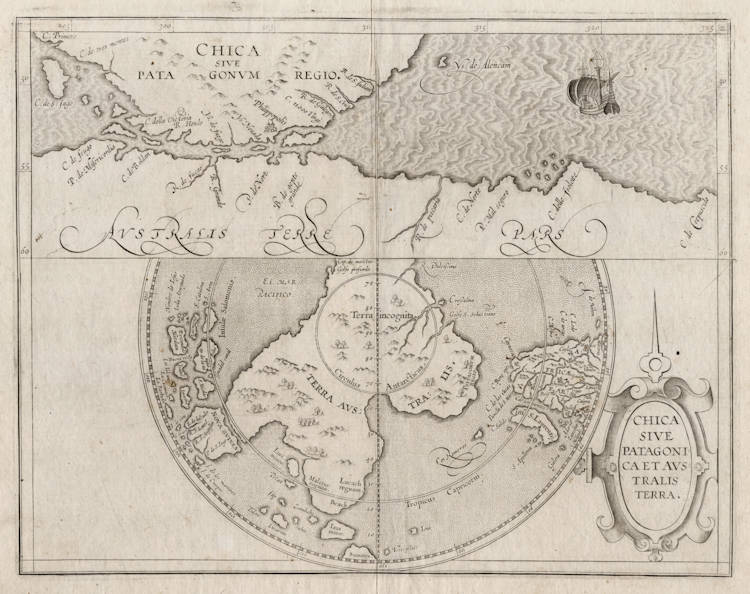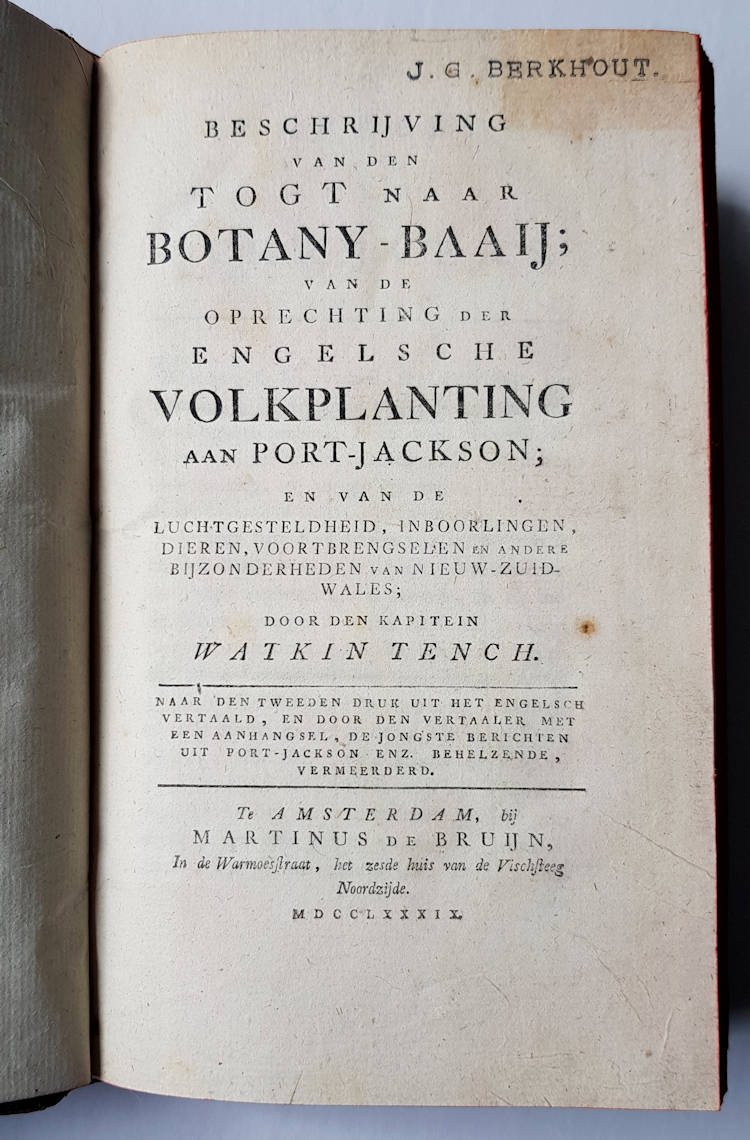Leen Helmink Antique Maps
Michiel Coignet's Zeevaert or the Art of Navigations
The item below is on hold, but if you enter your email address we will notify you in case it becomes available, or if we have another example that is not yet listed, or as soon as we receive another example.
Stock number: 19032
Image GalleryCartographer(s)
Michiel Coignet (biography)
Title
Nieuwe onderwysinghe op de principalste puncten de Zee-vaert / De Zeevaert oft conste van ter Zee te varen
First Published
Antwerp, 1580
This Edition
Amsterdam, 1598
Technique
Condition
pristine
Price
This Item is On Hold
Description
Enter the Dutch
The Coignet was on board of all early Dutch ocean crossings to all corners of the world, to the East, to the West, circumnavigating the globe and on Arctic travels.
FIRST DUTCH GUIDE ON THE ART OF NAVIGATION
Coignet's Dutch translation of Pedro de Medina's Arte de Navegar, issued in combination with his own practical navigation guide, was the first great book in Dutch on the art of navigation and was consequently an enormous stimulus to Dutch seamanship.
The first Spanish edition of Pedro de Medina was printed in 1545 and was followed by numerous later editions and translations into French (1554), Italian (1554), Dutch (1580) and English (1581). The Dutch edition is of highest significance as containing the important treatise of Michel Coignet.
(Nico Israel, Catalogue 22, 1980)
Background
From around 1595, the Dutch commanders and pilots of the pre-VOC companies were thoroughly educated by Petrus Plancius in long-range navigation on the high seas, based on knowledge from Iberian sources. He played a big role in the education and training of officers for the Amsterdam expeditions to the Far East. The directors of these pre-companies richly rewarded him for his services.
The navigators and skippers were trained using Coignet's new navigation guide, that was bound with his Dutch translation of the Medina.
Plancius had great involvement in the training and examining of the steersmen of the first Dutch Fleet to the Indies of 1595-97, and for this fleet specifically trained Frederick de Houtman and Pieter de Keyser to map and name the unrecorded celestial constellations on the southern hemisphere, many of these still bear the names that de Keyser and de Houtman gave to them.
He was also involved, together with Robert Robertsz le Canu, in the navigational training and route planning of the three Amsterdam polar expeditions commanded by Barentsz that sought to find a northeastern passage to the Far East.
The wooden lodge where Barentsz crew wintered at Novaya Zemlaya in 1596-97 in their attempts to reach China and the Spice Islands via a northeast passage, was rediscovered in 1871, almost 400 years after their epic efforts. Many artefacts were excavated, one of the most famous of which was a frozen copy of Coignet's navigation guide, now one of the exploration treasures of Amsterdam Rijksmuseum.
This was the first time that an arctic winter was successfully faced. The voyage stands in the first rank among the polar enterprises of the 16th century, and led to a flourishing whale and seal fisheries which long enriched the Netherlands.
Rarity
Exceptionally rare navigation guide of which only a handful of examples have survived. Lacking in all collections.
Condition
Contemporary vellum. A near flawless copy, no restorations or imperfections, complete with the requisite volvelles.
The first manual to make a clear distinction between Pilotage, Navigation and Cosmography
In the first chapter Coignet explains that navigation is divided into the "Ghemeyne zeevaringhe" [common navigation] -- navigating when land or navigational marks are in sight -- and the "groote zeevaringhe," [grand navigation] when astronomical instruments are being used.
Books on the art of navigation and cosmography, published by Cornelis Claesz
Around 1580, at the start of the great voyages that were to bring the first Dutch ships to the East and West Indies by the end of the sixteenth century, navigation took new pathways in its development. To sail on the open ocean, Dutch navigators had to have much greater skills than they had needed to sail along the European coasts. Now, they had to leave the familiar coastlines and venture out into unknown waters. Seeking guidance, Dutch seafarers naturally looked for mentors in Spain and Portugal. These two countries already had a long history of sailing the world's seas; they had built up sailing experience and had given the art of navigation a scientific basis. The knowledge that was locked up in foreign-language books suddenly took on a much greater relevance for Dutch navigation. The arsenal of information that existed in the Netherlands was greatly expanded when translations appeared of well-known reference works and textbooks from countries where navigational techniques were already more advanced. Besides the Iberian Peninsula, this also included England, where the art of navigation had reached new heights. It is not surprising that Cornelis Claesz seized the opportunity; he made sure that the pertinent publications also came out in Dutch editions.
Pedro de Medina and his Arte de navegar
Learned astronomers and geographers established working relations with men whose knowledge was drawn from experience. The problems these seamen had encountered in the course of their travels were unknown in coastal navigation. The success of such collaboration on the Iberian Peninsula led to the publication of important standard works on the art of navigation. Thanks to Pedro de Medina (1493-1567), developments in the technique of navigation could spread throughout much of Europe. His Arte de navegar, the most important manual in the field, was published in 1545 in Valladolid. No later editions of this work appeared in Spain itself. Nonetheless, the numerous editions in other languages – French (14), Italian (3), Dutch (4), and English (2) – gave this work its great importance for the advancement and proliferation of techniques of navigation.
The earliest Dutch edition, entitled De Zeevaert Oft Conste van ter Zee te varen, appeared in Antwerp in 1580. It was published by Hendrick Hendricksen in a translation by Maarten Everaert of Bruges. It was this edition that Willem Barentsz and Jacob van Heemskerck took along on the third polar expedition of 1596. It was this same Antwerp edition that they left behind after their famous winter on Novaya Zemlya. Nearly three hundred years later it was found there ([frozen in ice] now in the Rijksmuseum collection). The Dutch version of De Medina's work included a contribution by an adept in mathematics and navigation, namely Michiel Coignet (1549-1628) of Antwerp. Coignet's contribution was even more practical than that of De Medina, and the ordinary seaman found it clearer and easier to understand.
Later copies of this compilation were published in Amsterdam by Cornelis Claesz in 1589, 1592, and 1598. The Amsterdam and Antwerp editions were identical in content, except for the fact that the dedications (by the translator Everaert to Archduke Matthias of Austria, the other by Coignet to the Antwerp merchant Gillis Hooftman) were left out in the later three editions. New woodblocks were cut for the illustrations based on examples from the Antwerp edition. The title of the earliest edition published by Cornelis Claesz reads as follows:
De Zee=vaert oft Conste | van ter Zee te varen, vanden Excellenten Pilote Meester Peeter de Medina | Spaignaert.
Inde welcke niet alleene de Regels, Secreten, practijcken, en | constighe Instrumenten der seluer Consten begrepen zijn: Maer oock de | clare ende oprechte fondamenten der
Astronomijen, ende gantschen | loop des Hemels, op d'alder lichste ende duyde= |lijcxste verclaert worden.
Allen Cooplieden, Piloten, Schippers, ende anderen Liefhebbers der Astrono- | mijen tot nut en dienst: Wt den Spaensche ende Françoysche in onse Ne- | derduytsche tale ouergheset, ende met Annotatien ver- | ciert, by M. Merten Eueraert Brug.
Met noch een ander nieuwe onderwijsinghe, op de principaelste puncten | der Nauigatien, van Michiel Coignet.
T'AMSTELREDAM, | By Cornelis Claesz. opt Water, int Schrijfboeck, by deie oude | Brugghe. M.D.LXXXIX.
Michiel Coignet's contribution follows suit to Medina's work; it is also supplied with Cornelis Claesz's imprint:
Nieuwe onderwysinghe, | op de principaelste puncten | der Zee=vaert. Inhoudende
diversche nootelijcke regulen, constighe practijc= | ken, en sonderlinghe bequame
Instrumenten, die alle Piloten, Stier= | lieden, ende andere, die daghelijcx de Zee
hanteren, | vastelijcken behooren te verstaen.
Item een lichte, maer sekere ende perfecte maniere, om oost en West te varen, |
d'welck tot noch toe allen Piloten onbekent is gheweest.
Nu nieuwelijcken eerst (wt de conste van Mathematica) ghe- | practiseert, ende by een
vergadert, deur | Michiel Coignet.
T'AMSTELREDAM, | By Cornelis Claesz. opt Water, int Schrijfboeck, by d'oude |
Brugghe. M.D.LXXXIX.
Apparently, the work of De Medina and Coignet was in great demand, because Cornelis Claesz published new editions in 1592 and 1598.
Thanks to the translation of De Medina's book, Dutch seafarers could learn about subjects with which they were supposed to be acquainted: the interpretation and use of the sea chart; the technique of calculating the latitude of their position by measuring the elevation of the sun and the Polar Star; familiarity with the compass; calculation of the phases of the moon and the tides; determination of the time at night from the position of the stars.
Coignet's Nieuwe onderwysinghe treats the practice of navigation in more depth. It also presents a clear discussion of the principles of navigation, the winds, sea charts, and determining one's position at sea. Furthermore, it gives an extensive description of the current instruments of navigation such as the astrolabe, cross-staff, and the noctolabe. The contribution by Coignet increased the value of De Medina's book considerably. Coignet also described an instrument that he had made for use at sea, which he called the 'sea half-sphere' (hemispaerium nauticum). It was supposed to solve the problem of determining one's position. It should be kept in mind that it took a long time for this knowledge to trickle down to seafaring circles. Until deep into the seventeenth century, many navigators were unable to read or write, while simple mathematical calculations often posed insurmountable problems.
(Gunter Schilder Monumenta Cartographica VII)
Michiel Coignet (1549-1623)
Michiel Coignet was the son of the goldsmith and instrument maker Gillés Coignet. After working as a schoolmaster, he worked as Antwerp's wine gauger, and entered the service of the Archdukes Albert and Isabella of Austria as a mathematician and siege engineer. In about 1584 he set up his own workshop producing astrolabes, sundials, armillary spheres and surveying instruments.
Coignet invented several instruments and corresponded with Galileo Galilei (from 1588), Gerhard Mercator, Godefroy Wendelin, Ludolph van Ceulen and Fabrizio Mordente, whom he met during the latter’s 1584 sojourn in Antwerp. Among other things, Coignet invented and described instruments that had a function similar to that of the proportional compass. During the dispute over the invention of the proportional compass in 1610, Giovanni Camillo Gloriosi attributed the invention to Coignet and not to Galileo.
Strongly encouraged and financed by Gillis Hooftman, in 1580 Coignet published a treatise on navigation entitled Nieuwe Onderwijsinghe op de principaelste Puncten der Zeevaert ('New Instructions on the Principal Points of Navigation'). It was published by the Antwerp publisher Hendrik Hendriksen, as an appendix to the Dutch-language translation of Pedro de Medina's Arte de Navegar. In the appendix he pointed to the possibility of determining longitude at sea with watches on the ships. He also described some of his newly invented instruments such as the nautical hemisphere. The nautical hemisphere is an instrument with which the longitude problem could, in theory, be solved.
Around 1600 Coignet became involved in the publication of atlases. He edited various editions of the world maps of Abraham Ortelius. He added an introduction on projections and 13 maps to some editions of Ortelius' Epitome atlas. The Latin-language Epitome was quickly translated into English and French. Coignet edited the French version published in Antwerp. One of the new maps was a map with a description of Japan, for which he had obtained the information from Jesuit sources. Coignet also added an introduction to the atlas Speculum Orbis terrarum of Gerard de Jode.
Related Categories
Antique maps of the North Pole
Antique maps of the World
Antique maps of the East India Company
Old and Rare Books and Atlases
Antique maps of Australia
Antique maps of Japan
Antique maps of China
Antique maps of Southeast Asia
Antique maps of South America
Antique maps of North America
Antique maps of Canada
Antique maps of America
Antique maps of Africa
Old books, maps and prints by Michiel Coignet
Related Items
